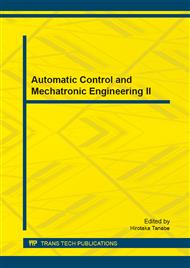p.561
p.565
p.569
p.574
p.578
p.582
p.586
p.590
p.597
Co-Simulation Research of In-Wheel Motor Drive Vehicle Steering Control
Abstract:
Aiming at the steering special requirement of in-wheel motor drive wheeled vehicle, the dual-steering control is adopted. The target of control system is the vehicle yaw rate, and active disturbance rejection controller is designed. Yaw moment torque is produced by adjusting the both sides of motor torque output to achieve the target of reference yaw rate. The vehicle kinetics model is built in the Adams, and the co-simulation model is designed base on the Adams and Matlab. The results of simulation demonstrate that the dual-steering control increased the vehicle outboard power output and decreased the steering radius, and improve the steering agility of the vehicle.
Info:
Periodical:
Pages:
578-581
Citation:
Online since:
September 2013
Authors:
Keywords:
Price:
Сopyright:
© 2013 Trans Tech Publications Ltd. All Rights Reserved
Share:
Citation:


